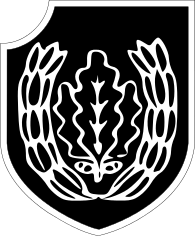16th SS Panzergrenadier Division Reichsführer-SS
| 16th SS Panzergrenadier Division Reichsführer SS | |
|---|---|
|
Insignia of the 16th SS Panzergrenadier Division Reichsführer SS | |
| Active | 1943–45 |
| Country |
|
| Allegiance | Adolf Hitler |
| Branch |
|
| Type | Panzergrenadier |
| Size | Division |
The 16th SS Panzergrenadier Division Reichsführer SS was a Panzergrenadier formation of the Waffen-SS during World War II.
History

.jpg)
Formed in November 1943 when Volksdeutsche recruits were added to the Sturmbrigade Reichsführer SS, which was used as the cadre in the formation of the new division. A Kampfgruppe ("combat group") from the division fought at the Anzio beachhead, while the rest of the division took part in the occupation of Hungary. It fought in Italy as a division from May 1944, until being transferred to Hungary in February 1945.
On June 27, 1944, the 16th SS-Panzer Grenadiers command post in San Vincenzo, Italy was overrun by the U.S. 1st Battalion, 133rd Infantry, 34th Infantry Division (Red Bulls). The command post was a town centre apartment which had been commandeered; when the owners returned to their apartment they found a signed large leather bound Stielers Handatlas which had been left behind.
In late summer 1944, a part of this division, SS-Panzer-Aufklärungsabteilung 16 (Reconnaissance Battalion 16), commanded by Major Walter Reder, was withdrawn from engagement with the American 5th Army then advancing on the Gothic Line to deal with an Italian Communist partisan unit, the Red Star Brigade (Brigata Stella Rossa). Operating out of a mountain complex centered on Monte Sole, just Southeast of the town of Marzabotto, and sitting astride communications to Bologna, the Red Star was seen as a significant threat to the German rear, both in terms of cutting communications and obstructing a possible route of retreat. Major Reder successfully completed his assignment and destroyed this guerrilla force. In August 1944 alone, in the Versilia and Lunigiana areas of Tuscany, there were three large massacres. 560 civilians were massacred at Sant'Anna di Stazzema on August 12, 159 at San Terenzo Monti on August 17 and 173 civilians murdered at Vinca starting August 24. All three of these reprisals were carried out by the 16th SS Panzer Grenadier Division.
Major Walter Reder, the SS commander who signed the order to execute the civilians at San Terenzo, was extradited to Italy in 1948 and tried in Bologna in 1951 for war crimes in Tuscany and at Marzabotto in Emilia-Romagna where 770 people were massacred making it the worst massacre of civilians committed by the Waffen SS in Western Europe during the war. He was found guilty and sentenced to life in prison, However, he was released in 1985 and he returned unrepentant to his native Austria where he was received with full military honors. He died in 1991.
In a case filed decades late due to misplaced evidence, ten SS officers of the 16th SS Panzer Grenadier Division were convicted of murder in absentia in 2005 at La Spezia for the slaughter at Sant'Anna di Stazzema. German prosecutors declined to proceed on the grounds that there was a lack of evidence tying specific murders to specific defendants.
A Kampfgruppe of the 16th Training and Replacement Battalion was based in Arnhem and took part in Operation Market Garden. The division surrendered to British forces near Klagenfurt, Austria at the end of the war.
Commanders
- SS-Sturmbannführer Friedrich Dern (Feb 1941 - ? 1941)
- SS-Sturmbannführer Ernst Schützeck (?1941)
- SS-Sturmbannführer Herbert Garthe (?1941 - Feb 1942)
- SS-Sturmbannführer Paul Massel (Feb 1942)
- SS-Obersturmbannführer Karl Gesele (Feb 1942 - Sept 1943)[1]
- SS-Gruppenführer Max Simon (3 Oct 1943 - 24 Oct 1944)
- SS-Oberführer Otto Baum (24 Oct 1944 - 8 May 1945)
Order of battle
- 35th SS Panzergrenadier Regiment
- 36th SS Panzergrenadier Regiment
- 16th SS Artillery Regiment
- 16th SS Panzer Battalion
- 16th SS Flak Battalion
- 16th SS Panzer Reconnaissance Battalion
- 16th SS Sturmgeschütz Battalion
- 16th SS Pionier Battalion
- 16th SS Signals Battalion
- 16th SS Supply Troop
- 16th SS Headquarters Battalion
- 16th SS Instandsetzungs Battalion
- 16th SS Medical Battalion
- 16th SS Training and Reserve Battalion
- 16th SS Feldgendarmerie Company
- 16th SS Panzergrenadier Training Unit
See also
- Marzabotto massacre
- List of Knight's Cross Recipients 16th SS Panzer Grenadier Division Reichsführer SS
References
- ↑ Bishop, Chris. The Essential Vehicle Identification Guide - Waffen-SS Divisions 1939-1945, Amber Books Ltd. 2007, p 144.

